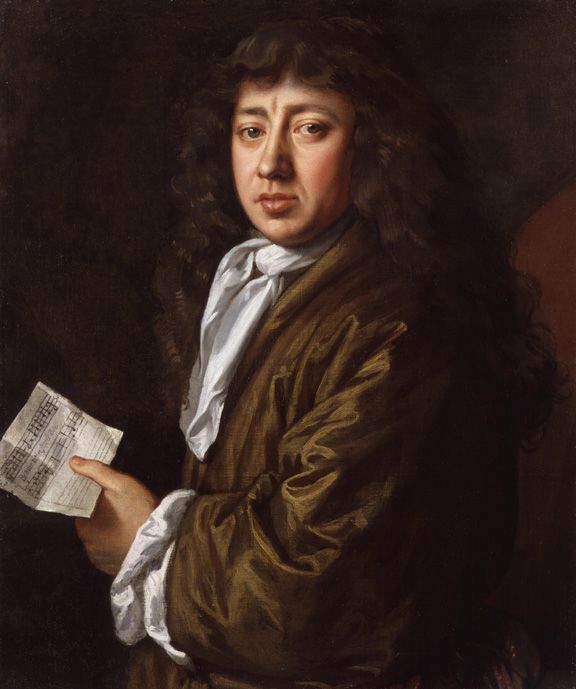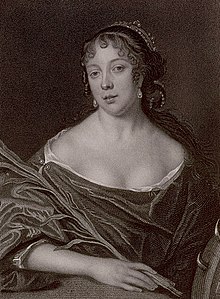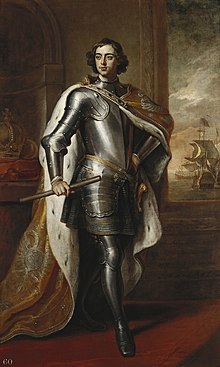An Unequal Marriage
 Samuel Pepys
was born 23rd February 1633, the son of tailor John Pepys, who
served the thriving law courts in London. Samuel was the fifth child, two of
his siblings died before he was born. A further six children were born after
him. Of the eleven children only four reached adulthood. Only the last
daughter, the second Paulina, and Samuel outlived their father.
Samuel Pepys
was born 23rd February 1633, the son of tailor John Pepys, who
served the thriving law courts in London. Samuel was the fifth child, two of
his siblings died before he was born. A further six children were born after
him. Of the eleven children only four reached adulthood. Only the last
daughter, the second Paulina, and Samuel outlived their father.
In 1653
Pepys senior was admitted to the ranks of the Merchants Taylors Company, one of
London’s Livery Companies, the same year that Oliver Cromwell made himself
Protector of the country. On Cromwell’s coat tails came Edward Montagu, one of
his neighbours and kin to the Pepys family.
Elizabeth
Pepys was born Elisabeth de St Michel in Bideford on 23rd October
1640. She was the daughter of Alexander de St Michel, a Frenchman converted to
the Protestant religion. Her brother Balthasar was born the same year.
Elisabeth’s mother apparently inherited land in Devon. And the St Michels moved
there from Ireland, where they met. Over the next few years any money they had
disappeared, as the small family wandered around Europe. Alexander took a
variety of jobs, including soldiering and working for a time at the court in
exile of Queen Henrietta Maria. In 1652, left alone in Paris, Elisabeth’s
mother placed her daughter in an Ursuline convent, and her brother Balthasar
was made a page to the Papal Nuncio. Infuriated by his wife’s actions Alexander
St Michel carried the family off to London.
Elizabeth
was just 15 when she married[iii].
Nothing is known about how she met Pepys, but he was obviously swept off his
feet by this bi-lingual pretty but penniless young girl. Pepys possibly persuaded
himself that two can live as cheaply as one and the couple were officially married
on 1st December 1655 in St Margaret’s Westminster. This was their
official wedding date, but the date they celebrated every year was the 10th
October. The marriage was consummated that night and it may be assumed that the
couple had an illegal wedding on that day[iv].
Elizabeth suffered from ‘painful humours and swellings’ in her vaginal region;
so intercourse cannot have been as pleasant for her as for Samuel.
In December
too, Edward Montague was called to the Admiralty Commission. In January he
found himself joint commander of the English battle fleet. Samuel was selected
to look after his important relative’s affairs at home and his apartment at
Whitehall, during Montague’s absence on fleet duties.
Unquiet Times
The
disparity in age and education did not make for a happy marriage and Pepys’
in-laws looked down upon his lowly birth (throughout his marriage Pepys never
visited the St Michel’s). Samuel and Elizabeth were living in one room,
possibly in the attics at Whitehall, with little money. Neither set of parents
were able to help the couple. Samuel for the first few years suffered the
complications of his kidney stone and Elizabeth
too suffered from ill health. She had no servants and the young girl, fed on
French romantic novels, had a fiery temper. Samuel as well had a temper that
would flare up to meet hers. Relatively early in the marriage Elizabeth walked
out without notice to her husband and did not return. It would appear that she
stayed with a lawyer named Palmer and his family. Palmer possibly encouraged a
reconciliation between the married couple.
In March
1658 Samuel Pepys successfully underwent an operation to remove his stone. He
was nursed by his cousin Jane Turner. The anniversary of the operation was one
of the high days of the Pepys household.
‘This day it is two years
since it pleased God that I was cut of the stone at Mrs Turner’s at Salisbury
Court. And did resolve while I live to keep it a festival, as I did last year
at my house, and for ever to have Mrs Turner and her company with me.’[v]
By now Pepys
was working as a clerk for George Downing, diplomat, MP and an official at the
Treasury. This work was in addition to looking after Montague’s affairs in his
absence with the fleet. Samuel and Elizabeth took advantage of the situation
and now rented half a house in Axe Yard, which must have reduced some of the pressures
within the marriage.
In May 1660
Pepys accompanied Montague’s fleet sent to escort the new king Charles Stuart
back to his kingdom. On the 13th July 1660, Samuel was made Clerk of
the Acts to the Navy Board; a post in which he was to be exceptionally
effective. This new job brought him into contact with the king’s brother the
Duke of York. In September Pepys was made a Justice of the Peace and in 1662
was made a younger brother of Trinity House[vi].
Momentous Events
On 5th July 1665 Pepys, now
working in the Navy Office, moved his family to Woolwich, following a severe
outbreak of the plague in the city. The plague was an intermittent problem,
re-occurring every few years. In June the numbers falling ill and dying in
London started to increase.
Samuel’s career was not interrupted by
the plague, nor was his private life. Pepys stayed in London, working at the
Navy Office, despite the thousands of Londoners dying every week. At the end of
the year the family returned home.
The following September another disaster
hit the capital. It was Pepys who informed the king and his brother of the fire
in London on 2nd September. It was his advice to blow up the
buildings in the path of the fire to create breaks, that helped stop the spread
of the devastation.
‘And word was carried to the King, so I was
called and did tell the King and Duke of York what I saw, and that unless His
Majesty did command houses to be pulled down, nothing could stop the fire.’[vii]
That lunch time Pepys and Elizabeth were
expecting guests for dinner and Pepys went home after walking through the
streets, observing Londoners fleeing with their goods and chattels. It was all
noted for posterity. There were five to dinner and a good time was had by all.
The party went out after dinner to observe the continuing mayhem.
By the time Samuel and Elizabeth
returned home, after spending the evening in an ale-house on Bankside, Pepys
was aware that the fire was moving in their direction. Carts were organised as
Samuel had his gold and books of accounts brought up from the cellar. Pepys
arranged a navy lighter to take his possessions to Bethnal Green for storage at
the house of a colleague. The wine was buried in the garden.
‘In the evening Sir W. Penn[viii]
and I did dig another and put our wine in it, and I my parmazan cheese as well
as my wine and some other things.’[ix]
Pepys had buildings around the Navy
Office blown up, in an attempt to save the building.
By now the Pepys were camping out in
their home. On the 5th Elizabeth woke Pepys to inform him that the
fire was burning at the bottom of Seething Lane. He took her back to Woolwich,
where she had stayed during the plague. The house was not burnt and Pepys
ordered it cleaned. Meanwhile he took time out to dally with a couple of female
acquaintances, one of whom Samuel was carrying on a long-term illicit
relationship with. Mrs Bagwell was the wife of a ship’s carpenter (hoping for a
promotion from the liaison) from Deptford. Elizabeth came home the next day.
‘And so home and unloaden them by carts and
hands before night, to my exceeding satisfaction: and so after supper to bed in
my old house, the first time I have lain there; and lay with my wife in my old
closet upon the ground, and Balty[x]
and his wife in the best chamber, upon the ground also.’[xi]
A Marriage Under Pressure
The Pepys
marriage would have been happier if Samuel had been less willing to drop his
breeches at the slightest encouragement. Indeed on numerous occasions he informs
us that he was sexually assaulting lower class women, if not actually raping them.
‘Finding Mrs Bagwell waiting
at the office after dinner; away elle and I to a cabaret where elle and I have
été before; and there I had her company toute l’après-dîner and had mon plein
plaisir of elle.’[xii]
Elizabeth
did not take her husband’s infidelities and chasing after women lying down:
‘And so home, where my wife
in mighty pain, and mightily vexed at my being abroad with these women – and
when they were gone, called them “whores” and I know not what; which vexed me,
having been so innocent with them.’[xiii]
Indeed,
Pepys betrayed Elizabeth with her companion Deborah Willett, who joined the
household in September 1667, but left precipitately thirteen months later,
after Elizabeth found Deb and Samuel in a heavily compromising position:
‘For my wife, coming up
suddenly, did find me imbracing the girl con my hand sub su coats; and endeed,
I was with my main in her cunny’.[xiv].  This was the
first and only time that Elizabeth caught her husband out in infidelity. The
betrayal was even more poignant as Deborah had been treated as a member of the
family, almost as a daughter by a couple who were unable to have children.
Pepys had commenced his attack on Deb’s virtue in the March of 1668, when he
sexually assaulted her. She was in a difficult position as she was totally
dependent on his and Elizabeth’s goodwill. In November Deb admitted the affair
to Elizabeth, who insisted on her dismissal, offering to slit Deb’s nose if
Pepys did not stay away from her. Pepys even agreed to be tailed by his man Will
Hewer to allay any suspicions Elizabeth might be harbouring.
This was the
first and only time that Elizabeth caught her husband out in infidelity. The
betrayal was even more poignant as Deborah had been treated as a member of the
family, almost as a daughter by a couple who were unable to have children.
Pepys had commenced his attack on Deb’s virtue in the March of 1668, when he
sexually assaulted her. She was in a difficult position as she was totally
dependent on his and Elizabeth’s goodwill. In November Deb admitted the affair
to Elizabeth, who insisted on her dismissal, offering to slit Deb’s nose if
Pepys did not stay away from her. Pepys even agreed to be tailed by his man Will
Hewer to allay any suspicions Elizabeth might be harbouring.
‘And so, well pleased, home
– where I find it almost night and my wife and the Dancing Maister alone above,
not dancing but walking. Now, so deadly full of jealousy I am, that my heart
and head do cast about and fret, that I could not do any business possibly, but
went out to my office.’[xv]
Then the
couple would often argue, not necessarily over Elizabeth’s flirtations, but
over some other matter picked up by the jealous husband. In the instance of the
dancing master; in order to restore his supremacy over her Pepys complained of
Elizabeth’s use of the word Devil some days later, after what appeared to
Samuel to be further provocations on Elizabeth’s part. This is a frequent
occurrence – Samuel has to be her master in all things.
The Final Separation
But however
much Samuel chased after other women, there is no doubt that he did love
Elizabeth: ‘Sad for want of my wife, whom I love with all my heart.’[xvi]
Elizabeth died on 10th November 1669, of typhoid fever, not long after the couple’s return from a trip to the Netherlands. Samuel was grief stricken and for several weeks was unable to apply himself to business with his normal thoroughness. He had stopped writing the diary in May, due to his worsening sight problems. Samuel did not remarry. In 1672 he was made an Elder Brother of Trinity House and served twice as Master. In 1673 the position of Secretary of the Admiralty was given to Pepys and he was elected MP for Castle Rising in the same year.
 Pepys
remained in public service until the Glorious Revolution, when he lost his job
as he would not switch allegiance from his patron James. Thereafter he lived in
retirement.
Pepys
remained in public service until the Glorious Revolution, when he lost his job
as he would not switch allegiance from his patron James. Thereafter he lived in
retirement.
Most of the
evidence of the marriage between Samuel and Elizabeth comes to us from Pepys
himself, via the medium of his diary. But even in his most private writings
Pepys could not lie to himself. And so we have a picture that is relatively
even-handed.
To judge Pepys by the morals of the 21st century is tempting. He was an abusive man, who attempted to control his wife through a variety of methods, including his gifts to her. He was also a serial sexual predator, by his own admission. But people and events must be considered within the context within which they lived or occurred. From 1660 on mores and morals were very different even from those prevalent fifty years earlier. By seventeenth century standards Pepys’ treatment of women would not have been considered extra-ordinary. In the reign of Charles II many men were quick to emulate the king’s promiscuity; not least of whom was Pepys’s patron, the Duke of York.
Bibliography
Samuel Pepys – the Man
in the Making – Arthur Bryant, Collins Press 1947
Pepys’ Later Diaries –
ed. CS Knighton, Sutton Publishing 2004
The Shorter Pepys – ed.
Robert Latham, Penguin 1987
Samuel Pepys – the
Unequalled Self – Claire Tomalin, Alfred A Knopf 2002
www.en.wikipedia.org
[i]
The headmaster of St Paul’s disliked taking boys for schooling over that age.
[ii]
Scholarships
[iii]
Marriage at this age was not unusual in the 17th century.
[iv]
Church weddings were declared invalid in August 1653.
[v]
Samuel Pepys – 26th March 1660
[vi]
Responsible for training of ship’s pilots
[vii]
Samuel Pepys - 2nd September 1666
[viii]
Navy Commissioner
[ix]
Samuel Pepys - 4th September 1666
[x]
Elizabeth’s brother
[xi] Samuel
Pepys - 13th September 1666
[xii]
Samuel Pepys - 23rd January 1665 – Pepys recorded his sexual
adventures in a mix of French, Latin, English and Spanish
[xiii]
Samuel Pepys – 9th May 1666
[xiv]
Samuel Pepys – 25th October 1668
[xv]
Samuel Pepys --15th May 1663
[xvi]
Samuel Pepys – 21st June 1663











